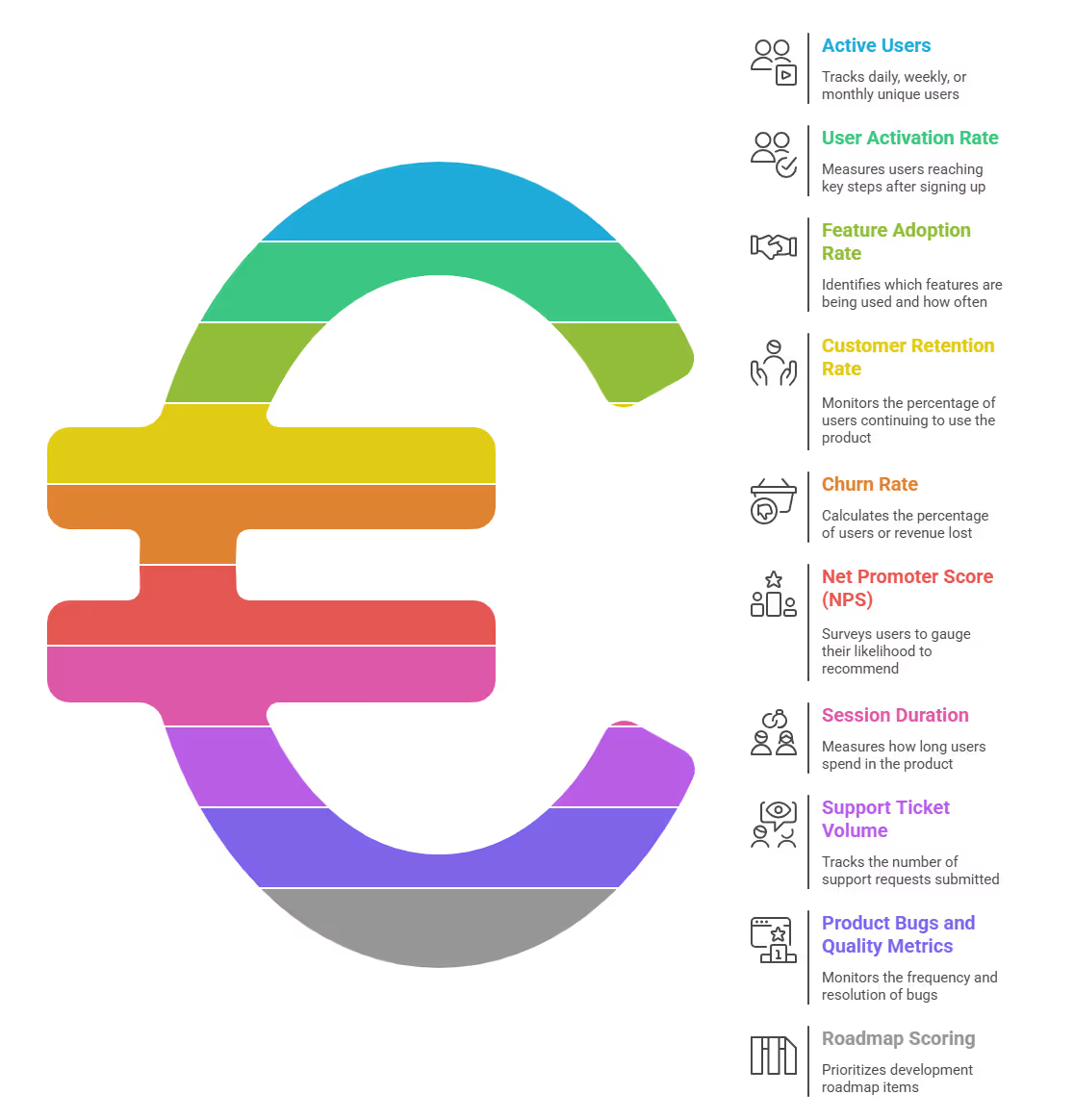SaaS Product Management Metrics

SaaS product management metrics are measurable indicators that help product managers track adoption, retention, revenue, and customer satisfaction in SaaS products. The most critical metrics include ARR (Annual Recurring Revenue), MRR (Monthly Recurring Revenue), CAC (Customer Acquisition Cost), CLV (Customer Lifetime Value), Churn Rate, Net Revenue Retention, and Product Adoption Rate. These metrics enable U.S. SaaS leaders to make informed decisions, prioritize product features, and optimize for sustainable growth.
In the fast-paced U.S. SaaS market, success is determined by how well you measure and act on the right product metrics. SaaS product management metrics are more than numbers, they’re the foundation for understanding customer behavior, product-market fit, and long-term profitability. Whether you’re scaling a startup or managing an enterprise SaaS product, focusing on the right KPIs such as ARR, churn, and adoption can help you align product strategy with growth goals.
SaaS product management metrics are measurable data points that help product managers evaluate the performance, growth, and user engagement of a software-as-a-service (SaaS) product. Tracking these metrics helps you make better decisions, improve customer satisfaction, and drive product success.
Here are key SaaS product management metrics to monitor:
- Active Users (DAU/WAU/MAU):
- Track the number of unique users interacting with your product daily, weekly, or monthly.
- These numbers help you understand user engagement trends and the product's overall health as they show whether people consistently use your software.
- User Activation Rate:
- Measure how many users reach key steps or milestones after signing up, such as completing onboarding or using a core feature for the first time.
- A higher activation rate indicates a smoother onboarding process and better initial product experience.
- Feature Adoption Rate:
- See which product features are being used and how often.
- Tracking adoption rates helps you identify valuable features and areas where improvements are needed, guiding your product development focus.
- Customer Retention Rate:
- Monitor what percentage of users continue using your product over time.
- High retention means your product delivers ongoing value; low retention signals churn or lost interest that needs to be addressed.
- Churn Rate:
- Calculate the percentage of users or revenue lost during a specific period.
- Understanding churn helps you reveal dissatisfaction areas and take actions to retain more customers.
- Net Promoter Score (NPS):
- Survey users to find out how likely they are to recommend your product to others.
- NPS measures customer loyalty and helps you spot at-risk accounts and track improvements over time.
- Session Duration:
- Measure how long users spend in your product during a typical visit.
- Longer average sessions suggest deeper engagement and usability; shorter sessions can point to poor value or confusing UX.
- Support Ticket Volume:
- Track the number of support requests or tickets submitted by users.
- Trends in support tickets highlight product pain points and the effectiveness of your help resources or new features.
- Product Bugs and Quality Metrics:
- Monitor the frequency and type of product bugs reported, and how quickly you resolve them.
- Fewer bugs and faster resolutions mean better product reliability and happier users.
- Roadmap Scoring:
- Use scoring criteria (like reach, impact, confidence, and effort) to prioritize items on your development roadmap.
- Prioritizing with clear metrics ensures you focus resources on work that moves the product and business forward.
Each of these metrics provides you different insights, on customer satisfaction, product engagement, financial impact, and quality. Regular tracking helps product managers make data-driven decisions, improve user experience, and support sustainable SaaS growth.

Why SaaS Metrics Matter for Product Managers in the U.S.
Understanding SaaS metrics is critical for product managers who want to drive real results, make informed decisions, and succeed in the competitive U.S. technology market. These metrics give you a clear view of how your product is performing, how users behave, and what areas need improvement.
Here’s why tracking and using SaaS metrics should be part of every product manager’s routine:
- Metrics provide a reliable way to measure product performance and growth. You can spot improvement areas early, track progress toward goals, and avoid making decisions based on assumptions or gut feelings.
- By regularly monitoring key data, you catch problems, like user drop-off or low feature adoption, before they become major issues. This helps you save your product and protect business revenue.
- Product metrics offer direct insights into user behavior, showing which features customers use most, how often they engage, and where they experience difficulties. This information drives better user experience and product-market fit.
- Tracking metrics means you can clearly demonstrate your product’s value to stakeholders. Use hard data to show how your work impacts revenue, user retention, or satisfaction, making it easier to get support from leaders and other teams.
- A data-driven approach steers your team in the right direction. Numbers settle debates, help prioritize features, and align developers, marketers, and sales teams around shared goals and priorities.
- SaaS metrics connect directly to business outcomes. Metrics like Monthly Recurring Revenue (MRR), Customer Acquisition Cost (CAC), churn rate, and Lifetime Value (LTV) reveal how changes in your product influence the company’s bottom line.
- In the U.S., where SaaS competition is fierce, using the right metrics to support product-led growth is essential. Metrics help you spot trends, adapt quickly, and prove your product can compete with leaders like Slack and Zoom.
- Customer satisfaction metrics, such as Net Promoter Score (NPS), allow you to measure loyalty, predict churn, and uncover opportunities to improve customer retention and advocacy.
- Product metrics ensure your development roadmap stays aligned with customer needs and market realities. They stop you from wasting time and money on features that users do not value.
By taking metrics seriously, product managers avoid costly mistakes, make smarter decisions, and lead their teams with confidence.
Common Mistakes in Tracking SaaS Metrics
Tracking SaaS metrics is essential for understanding business health and driving growth. But many teams make mistakes that lead to confusion, missed opportunities, or even wrong decisions.
Here are the most common pitfalls to avoid in a clear, actionable format:
Failing to Define Metrics Clearly
- Do not assume everyone knows what each metric means.
- Always agree on precise definitions for all tracked metrics, like Monthly Recurring Revenue (MRR) or churn, so calculations are consistent across teams and tools.
- Document these definitions and share them with everyone involved in data tracking and reporting.
Tracking Too Many or Irrelevant Metrics
- Trying to measure everything creates information overload.
- Focus only on the metrics that truly reflect your business goals and health, such as CAC, LTV, retention, and active usage, rather than collecting data for vanity or curiosity.
- Regularly review your list and remove anything that does not inform a decision or action.
Relying on Vanity Metrics
- Metrics like website traffic, app downloads, or social likes can sound impressive but rarely show actual business value.
- Instead, pay close attention to actionable metrics, such as customer retention or conversion rates, that lead to meaningful insights and better decisions.
Inconsistent Tracking Processes
- If you change how you track or calculate a metric midway (for example, switching MRR formula), you lose the ability to compare performance over time.
- Set a reliable schedule for measuring each metric, and keep the process unchanged unless you update and document it everywhere.
- Train your team to follow the same routines for accurate, trendable data.
Ignoring Customer Churn and Retention
- Focusing only on new customer signups hides bigger issues if you are losing customers at a high rate.
- Monitor churn and retention closely.
- Take swift action when you spot a rising churn trend, before it becomes a serious business threat.
Failing to Track All Conversions
- Do not limit conversion tracking to new customer signups.
- Include free trial users, demo requests, upgrades, downgrades, cancellations, and reactivations.
- A full picture lets you understand true funnel performance and where to optimize.
Comparing Data Incorrectly Across Time Periods
- Comparing a product launch week to a quiet month or short-term spikes to long-term performance can lead you astray.
- Standardize your analysis periods, use rolling averages or cohort analysis, to get an accurate, apples-to-apples view.
Not Standardizing Metrics Across Tools
- Each analytics or CRM tool might have its own way of calculating the same metric.
- Without standardization, you risk misinterpretation or double-counting.
- Audit your tools and create a single source of truth for each metric’s calculation method.
Not Taking Action on Insights
- Collecting or viewing metrics is not enough.
- If you spot issues, such as high churn or low activation, set up workflows to investigate and fix them immediately.
- Make tracking actionable by tying metrics to concrete changes in product, sales, or marketing.
By actively avoiding these mistakes, SaaS teams can make sense of their data, spot real opportunities, and drive genuine business growth without confusion or wasted effort.
Tools and Dashboards for SaaS Metric Management
Managing SaaS metrics requires more than spreadsheets. Companies need the right tools, dashboards, and integrations to track performance in real time and connect data with decisions.
The tools not only centralize numbers but also provide visibility across revenue, product usage, churn, and customer health.
- Business intelligence dashboards help leaders see revenue, churn rate, and growth patterns in one place. Tools like Tableau, Power BI, or Looker connect different data sources and simplify trends through visual reports.
- Subscription analytics platforms track recurring revenue metrics like MRR (Monthly Recurring Revenue), ARR (Annual Recurring Revenue), and LTV (Customer Lifetime Value). These platforms give SaaS teams a pulse on retention and growth.
- Product analytics tools capture how users interact with features, where they drop off, and which actions drive engagement. This helps teams align product improvements with real user behavior.
- Revenue operations dashboards integrate sales, marketing, and customer success metrics. They show funnel conversion stages, customer acquisition cost (CAC), and upsell opportunities.
- Automated alert systems ensure teams act quickly. For example, if churn spikes or product adoption drops, alerts trigger so issues can be fixed before they grow larger.
Future Trends: AI-Driven SaaS Product Metrics
AI is reshaping how SaaS companies measure, interpret, and act on metrics. Instead of just reporting numbers, AI-powered systems can recommend next steps and predict future outcomes.
- Predictive analytics allow companies to identify customers who may churn before they actually do, giving teams the chance to improve retention.
- Automated forecasting makes revenue planning faster. AI can look at historical patterns, seasonality, and product adoption trends to deliver accurate growth projections.
- Intelligent segmentation groups customers based on behavior, usage, and purchase intent, helping companies personalize offerings and engagement strategies.
- Real-time anomaly detection spots unusual spikes or drops across revenue, signups, or usage, which reduces the time taken to respond to risks or opportunities.
- Natural Language Insights let teams ask AI engines simple questions like “Which feature drives the most upsells?” and receive instant explanations instead of digging through dashboards.
Building a Metrics-Driven SaaS Culture
The best dashboards and AI tools only work when teams build the right culture around them.
A metrics-driven SaaS company runs on data, not gut feeling.
- Share metrics across teams so sales, product, marketing, and success teams align on the same goals instead of chasing siloed targets.
- Focus on actionable insights instead of overwhelming teams with vanity metrics. Leaders should highlight numbers that drive immediate decisions and measurable outcomes.
- Encourage experimentation by allowing teams to test new ideas, measure results, and refine based on data rather than opinions.
- Celebrate wins with data to reinforce adoption, when teams see retention improve or revenue grow because of their actions, it builds trust in the metrics.
- Evolve practices continuously because SaaS businesses change rapidly, and the metrics that matter today may not be the same tomorrow.

